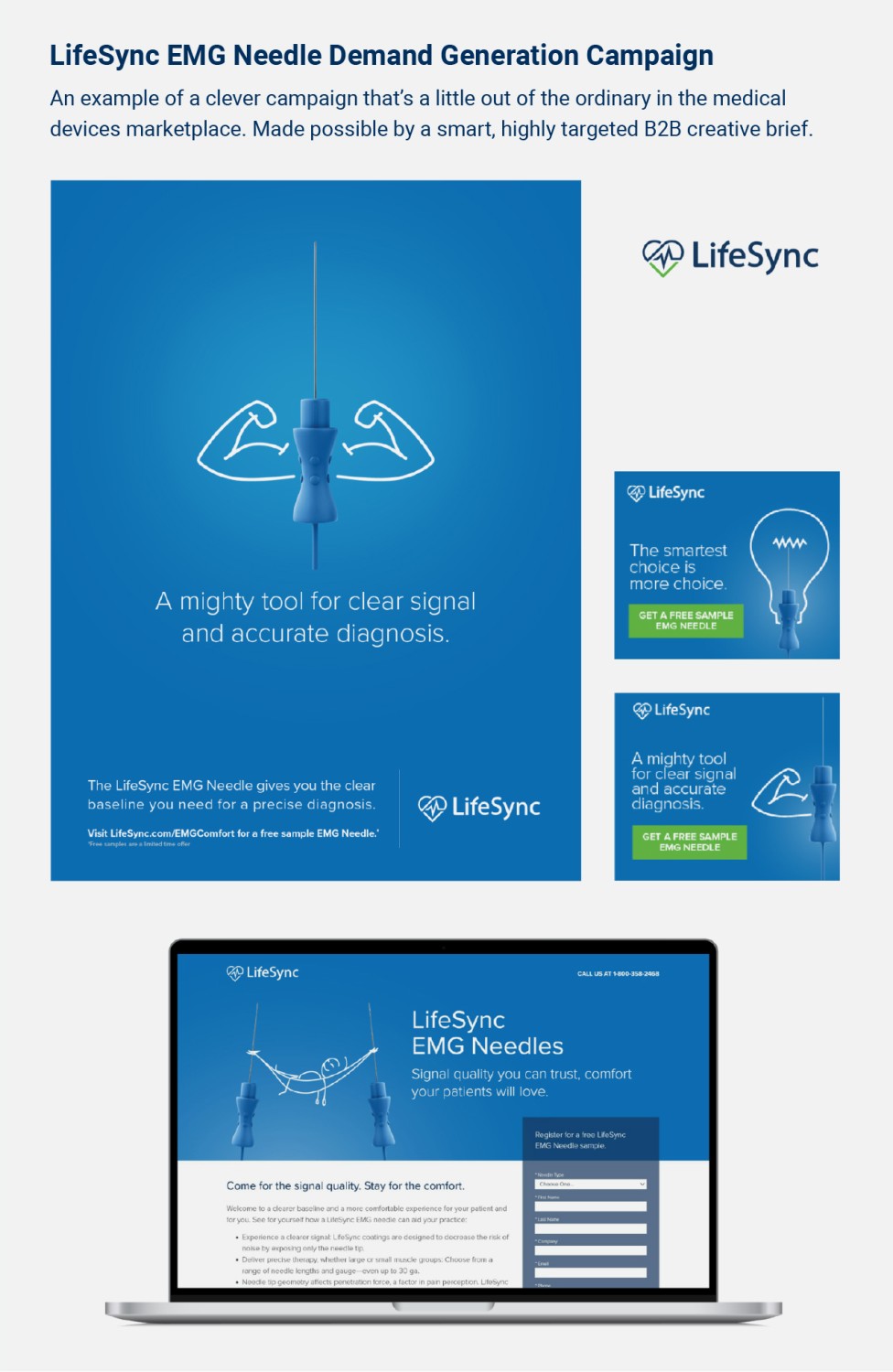Everything You Need to Know About the B2B Creative Brief

Posted on: February 7th, 2023
Consumer marketing often has mass appeal and offers a lot of flexibility in terms of risk-taking and conceptual development. Although B2B marketing can be construed as more regimented and less fun than consumer marketing, creative development in the B2B arena is, perhaps, an even more thoughtful and more highly targeted marketing and communications process. The process of great advertising concept development begins with the creative brief. Done correctly, the creative brief aligns client and agency stakeholders and sets the stage for ideas that support the business objective. This article will capture Merit Mile’s best practices for developing B2B creative briefs for winning marketing and advertising campaigns.
The B2B Creative Brief – Begin with the Essentials
The B2B creative brief is, essentially, the document that puts the creative team in a position to succeed. As such, starting with the basic fundamentals is a great place to begin.
The foundation for these fundamentals is largely centered on what the overarching client objective is. Is the objective to educate our audiences; generate buyer demand for the product/service; creative awareness; or something else? Go ahead and get specific because confusion about the goals at the onset will likely cascade into misinterpretation elsewhere.
Next, what exactly does the scope of work entail? Detail matters and having a clear understanding of the scope will ensure all parties align on what the outcome should look like. Is the client looking only for conceptual ideas? If so, how deep or elaborate should the ideas be? To a degree, the scope details put a box around the entire project. As you’ll read later, there is no better way to push the envelope and get outside the box than understanding what it looks like first.
The third element of the project fundamentals section of the B2B Creative brief is the project deliverables section. If the scope of work paints a picture of the project “box,” the deliverables are, in essence, the contents of that box. The deliverables section of the B2B Creative brief should leave no ambiguity as to what the agency’s outputs should be throughout the entire project.
Here’s a good baseline for any project deliverables section for your next B2B creative brief:
Project Deliverables – 4 in Total:
- Up to five creative concepts
- Business rationale for each concept
- Supporting messaging/light copywriting for each concept
- Creative concept presentation delivered in PPTX format (less than 20 slides)
The last section of the project fundamentals section of the B2B Creative brief is the Schedule section. Here is where the rubber meets the road, and the agency aligns calendar dates with project milestones. This section of the brief also serves as a great resource and reminder for any billing/invoicing needs that should take place throughout the project. In many cases, the client should have the ability to sign off on these dates so expectations are set and met. Remember, the B2B Creative brief is a great tool for building consensus and ensuring all parties stay in alignment. Pro-tip: when developing your project schedule, apply a number of days for completion than specific calendar dates. This way, the completion of a previous milestone triggers subsequent actions and milestones.
The B2B Creative Brief – Audience and Key Message
With the foundation laid, the walls and rooms of your B2B creative brief structure are, by and large, the audience and key message sections. Let’s break down each of these important pillars for better context as these areas will truly empower the creative team and allow them to shine brightly.
When referring to audiences in Consumer marketing, we’re often communicating to audiences on a wide scale. For example, male adults 25‑54 with household incomes of $100k+ is a specific, albeit broad and typical Consumer marketing target audience.
The science and art of a good B2B creative brief, however, is hyper-focused on a particular target audience. Sometimes B2B marketing assignments focus not on specific people, but instead on a unique industry or vertical market. Because we’re targeting business buyers, the audience section can depict more detail: not only gender and age, but also industry, decision-making authority, title, geography, and more. Business persona development in B2B advertising is an even better way to target in a B2B creative brief as this type of demographic and psychographic detail will help creatives ideate in a much more specific manner. So, rather than casting a wide creative net around a wide audience, B2B concepts can isolate a particular buyer that best meets the profile of the campaign objective. For more on B2B persona development, check out the article linked here.
Whether Consumer or B2B, the best advertising concepts often start with great creative briefs. And if you’re looking to identify one section within a B2B creative brief that distinguishes itself as the most critical, it may be the key message section. A key message in a B2B creative brief is the one big takeaway that we, as marketers, want our target audience to remember. Often, it’s a bold proclamation, or a factual statement with supporting numeric support (e.g., ROI or savings %). The best key messages, however, are short statements that speak to the benefits (not the features) of the product or service you’re promoting. For example, here are two recent Merit Mile B2B Creative brief Key Messages that were used in two unique client campaigns:
Healthcare/Medical Device Campaign:
“LifeSync EMG needles increase patient comfort and caregiver quality.”
Satellite Communications Device Campaign:
“Iridium gives you the peace of mind and freedom to easily stay connected (to life and work) from anywhere.”
If you consider your target audience and key message as the walls and rooms of the B2B creative brief structure, those important areas need reinforcement for safety and reliability; or support in general terms. Examples of helpful support that complement a key message include message tone, existing or desired positioning, and any preconceived attitudes toward the product or service you’re promoting. Altogether, a solid key message along with factual supporting insights will help your creatives land on winning ideas during any B2B creative scope of work.

The B2B Creative Brief – Final Touches Lead to Great Creative Execution
With the foundation of your B2B creative brief cemented as the project basics; and your middle walls and rooms designed with your target audience and a key message; now is the time to put the finishing touches on your winning B2B creative brief. To continue the metaphor, let’s envision this section as the rooftop of your structure. Chances are, your creative team can ideate and execute against the program scope without these finer details, but if you’ve come this far, why not go the full distance?! That’s right, let’s put a shiny roof on this structure and in the process make bold strides at ensuring both agency and client success.
Some helpful suggestions to incorporate into your B2B creative brief:
- Competitive awareness: understanding what the competition is doing will naturally identify gaps in the marketplace. A bit of homework in this area, be it a competitive SWOT, or shallow dive understanding of competitive trends, will also help your creative team avoid common pitfalls like presenting concepts that may be deemed derivative or dated.
- Evidence: are there any factual statements that can or should be communicated to help sell your creative vision? Things like patents, customer testimonials, third-party reviews, or industry awareness add credibility to B2B creative concepts.
- Legal: ask or research any limitations that may automatically reject a concept on presentation day. There’s nothing worse than presenting a winning idea only to be shot down by the legal team. Don’t be afraid to ask about legal limitations at the onset of any B2B creative assignment and be sure to document the same in your brief.
Since 2007, the team and I at Merit Mile have been marketing B2B products and services for leading organizations worldwide. Please take a look at our most recent agency case studies and portfolio showcases today. If you have any questions, suggestions, want help developing your next brief, or want to discuss working with us in general, drop us a line at Hello@MeritMile.com anytime!